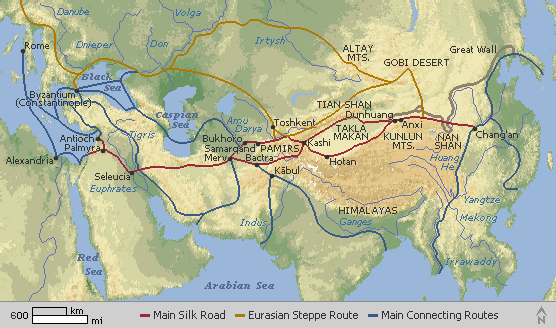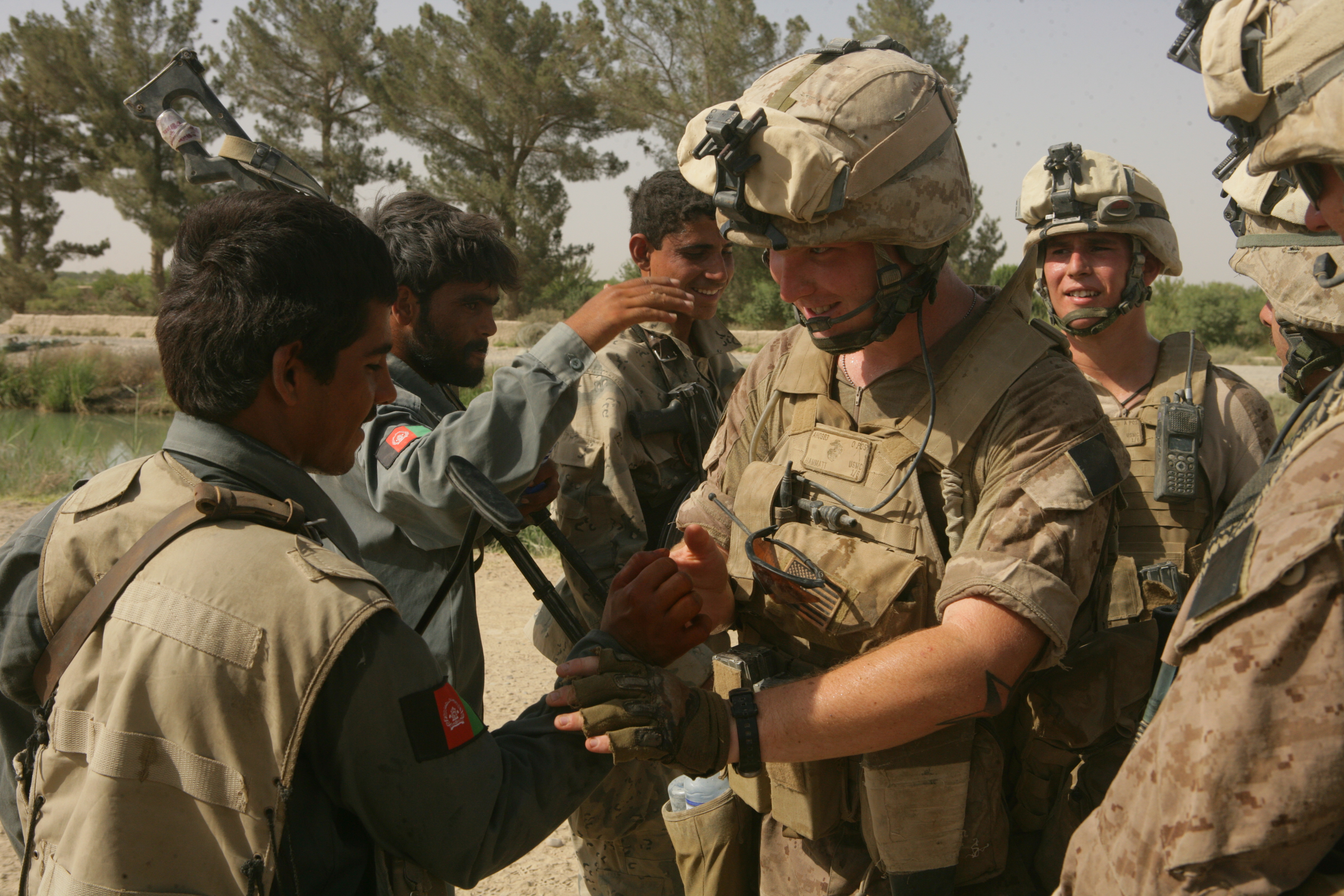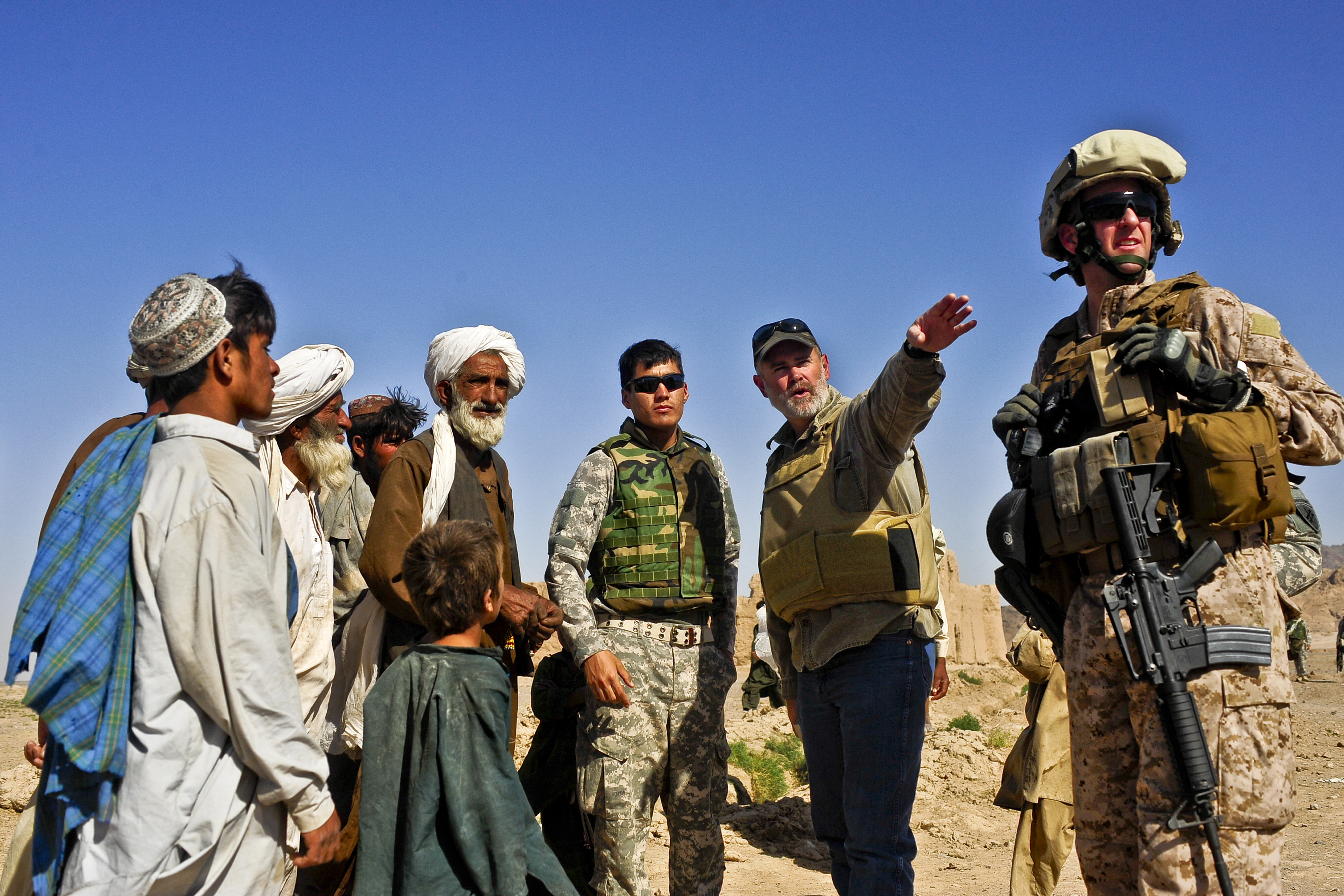The Silk Road from China to the Mediterranean Sea is one of the oldest and significant merchant routes in the world |
During our event-filled, jam-packed, three-day, cross-country marathon we would visit three diverse regions (Kabul, Jalalabad and Kandahar). Kandahar, the second largest city in Afghanistan, is a major trading center for sheep, wool, cotton, silk, fruit and tobacco. Many empires have long fought over the city, due to its strategic location along the the Southern Asian trade routes. Afghanistan, a land-locked mountainous country, has long been a vital crossroads between the East and the West which centuries before was part of the ancient Silk Road.
24th MEU working with the locals from Garmsir. |
The local government and citizens of Garmsir District are working to correct the flow of the river back to its original course, after high water levels from the winter. |
Besides visiting with Afghans, it was a pleasure meeting and greeting the Soldiers, Marines, Sailors, Airmen working in cohesion from all 28 NATO nations -- 41 total -- looking ahead and planning the way forward in unity and solidarity.
This visit confirmed to me that this was not just an ad hoc coalition, but an alliance that like the intricately-crocheted Afghan blankets were closely-knit and like traditional tribal family had great staying power.
24th Marine Expeditionary Unit (MEU)
Afghanistan is the geography of a running waterfall. In the northern part of Garmsir there is an intricate canal that serves as in irrigation system. It was built by USAID in the 1950's. Although the southern region of Afghanistan is barren and dry, all routes, man and beast, lead to the river.
If you look at a map of the Helmand province, you will notice right away that the north end of the river bulges out. That is why the Marines dubbed this section the "Snake Head".
The Taliban has a stronghold in Southern Afghanistan. The Helmand province in southern Afghanistan is where over 50% of Afghanistan's opium is produced. Thus this became a vital area for ISAF to maintain security and stability.
By the end of December 2007, the situation in the Helmand Province reached a stalemate. In early 2008, the 24th Marine Expeditionary Unit arrived to reinforce the ISAF fight.
Gamsir Province
Fighters and weapons from Pakistan funneled through Garmsir, which became a stronghold that allowed insurgents to push their logistics.
That is why the bad guys refused to concede. But the US Marines were a notch tougher and a lot more sophisticated.
With their eyes turned to Garmsir, the Marines' first task was to secure key routes in an area that NATO had not had a presence in years.
In April 2008, the 24th MEU sent a battalion of Marines to Garmsir.
Why Garmsir is Important
In Afghanistan, people live, grow crops and conduct trade within walking distance to the river. Beyond that, it is a barren desert. The Helmand River which cuts through the heart of Gamsir, is the longest river in Afghanistan and the major source of water in the desert.
The Battle Begins
The Marines seized Garmsir and the Taliban forces easily withdraw and take up positions further south. After seizing the stronghold, the Marines continued south into an area where the insurgents had built bunkers and tunnels capable of withstanding coalition airstrikes.
Marines Encounter Resistance
One early morning, the sound of automatic weapons crackled through the air. For the next 48 hours, Charlie Company fought aggressively against relentless Taliban fighters. Within a day, the Marines penetrated the enemy and held the territory.
The 24th MEU CO, Colonel Peter Petronzio captured the Marine's toughness precisely, "The Marines are as tough as woodpecker lips."
But this was not the last engagement -- the Marines would encounter many, many more over the next month.
After seizing Garmsir, the Marines pushed further south where the Taliban had built bunkers and tunnels.
Clear
Insurgents fought hard from several fortified positions including civilian homes. They also dug trench lines and bunker systems. Surprisingly, they stayed and fought fiercely for more than a week rather than retreat. After the Marines cleared the insurgents, they held the ground by securing the area.
Hold
This incident alerted Marine leadership that the town was a critical logistical hub for insurgent operations, so the Marines were ordered to remain in the area.
Rebuild
On 8 Sept, 2008 the 24th MEU returned control of Garmsir to British forces after securing in for six months. The plan now is for ISAF forces to pass along the mission of "holding and rebuilding' to the Afghan army (with assistance from ISAF)
What I Like about COIN: "Clear, Hold and Build"
The strategy is not on seizing terrain or destroying insurgent forces. The objective is the population -- clearing the insurgents (just as the 24th MEU did in in Garmsir) and providing the population with security.
The emphasis should also be along the border with Pakistan where many Taliban fighters are crossing over.
The Challenges of Counter Insurgency
COIN may very well be the key to victory in Afghanistan. But in order to be successful, the initiative requires time and an extensive amount of manpower. It also requires the local population to be loyal to the local government which takes patience and peserverance.
The PRTs
This is where PRTs really come into play with the implementation of Counter Insurgency. PRTs area critical because they support the military commander and lessen the impact of military operations on the civilian populations.
The PRTs act as a critical liaison between the civilian population near a war zone and the military commander, both serving as a conduit for information and providing critical assistance and support (training, security, logistics, governance).
The 4th Civil Affairs Detachment assists the locals in diverting the water back to its original course. What Must be Done As we travelled to the borderland between Afghanistan and Pakistan, we met with the Afghan spokesman who told us what must be done in order for Afghanistan to be successful against the insurgency and corruption. However, while we were being briefed, I knew that this would be a tremendous challenge for this country, deeply rooted in corruption. In addition, drug trafficking is rampant, generating billions in revenue per year and corroding the credibility of the Afghan government. But there is hope in the horizon. The country has great people and also has sufficient natural resources (copper, iron ore, water) to succeed as a country and sustain itself without drugs. It is the government that has failed and continues to struggle to maintain control and to develop and govern its resources and its people. This is precisely where the US and NATO can critically come into play. The good thing is that US Drug Enforcement Agency is working closely with the Afghan counter narcotics forces. Although poppy fields is endemic in the countryside with the country producing nearly 92 percent of the world's opium, there is hope that the drugs and labs can be quickly eradicated. But in so doing, NATO has to work hard in eliminating both the insurgency and the drug trade. Together they go hand-in-hand, and I believe that drug money is being funneled to the Taliban. |
I was also particularly impressed with the Provincial Reconstruction Teams built as a means of facilitating reconstruction efforts in provinces outside the capital of Kabul. The PRTs in essence improves security, provides governance and spurs development.
A PRT could include Civil Affairs as well as a member of USAID, the Department of State, Dept of Agriculture and DoJ. The amazing thing, is that the PRTs work in very remote areas in 19 PRTs across the country (There are 26 total PRTs in Afghanistan).
What is incredible about the whole concept is that the civil affairs teams work with the local Afghans to determine their specific needs. The Afghans are encouraged to route their requests through their local governments. Thus the PRTs have created an enterprise system and promoted trust amongst the tribal, village and religious leaders in the service and reliability of the government. When the PRTs win support of the Afghan people, they undermine the credibility of the Taliban.
But one of their main goals is to create self-sufficiency and self-sustainability. The more the Afghan people can rely on themselves and less on outside help, the better off we all will be for our mission and our country.
I was impressed and left with a thankful heart and I am grateful for their service, sacrifice and commitment -- tonight I slept well. The serene coziness of the Serena Hotel provided the setting, a stone-throw away, in the historic old section of Kabul, a bustling bazaar, nestled along its narrow, crooked streets hawking brilliantly flowing turbans, beautifully-weaved Afghans, dried, tropical fruit, aromatic tobacco and a bright, enigmatic smile and a warm, Afghan greeting.










No comments:
Post a Comment